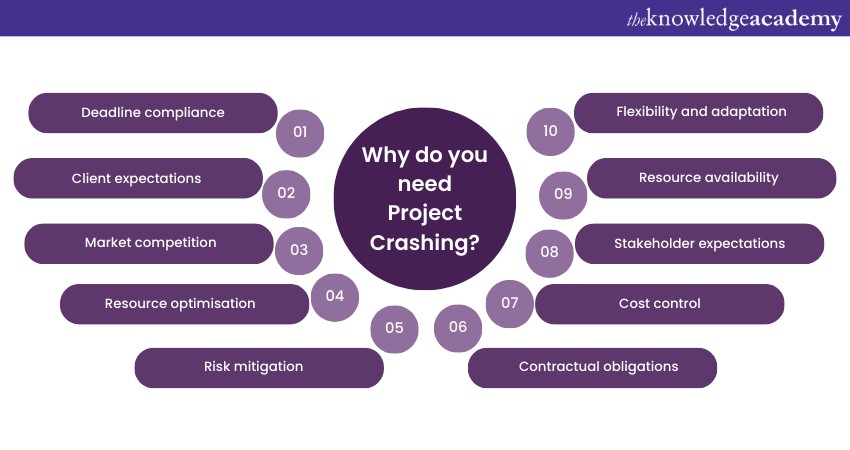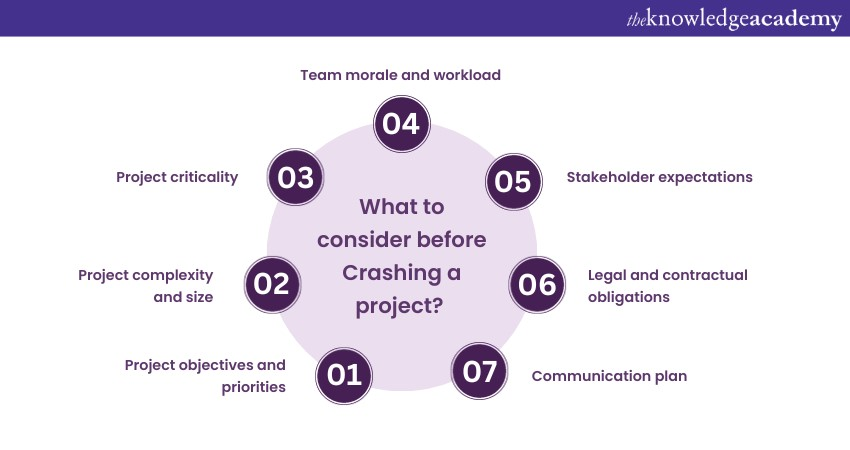We may not have the course you’re looking for. If you enquire or give us a call on +40 316317743 and speak to our training experts, we may still be able to help with your training requirements.
We ensure quality, budget-alignment, and timely delivery by our expert instructors.

The term ‘Crashing in Project Management’ plays a pivotal role in Project Management. Projects, whether they involve constructing a building, developing a software application, or organising a significant event, are governed by deadlines. Crashing in Project Management is a technique to shorten the duration of a project by adding more resources to the critical tasks.
Crashing also involves increasing the project cost and may affect the quality and scope of the project. Therefore, it is important to analyse the benefits and drawbacks of Crashing before applying it to a project. In this blog post, we will explain what Crashing in Project Management is, why it is used, and how to implement it effectively.
Table of Contents
1) What is Crashing in Project Management?
2) Why do you need Project Crashing?
3) How to crash a project?
4) What to consider before Crashing a project?
5) Advantages and disadvantages of Crashing in Project Management
6) Conclusion
What is Crashing in Project Management?
Crashing in Project Management is a powerful technique used to expedite a project's completion when it's essential to meet stringent deadlines or cope with unexpected delays. This strategy involves allocating additional resources, often in terms of time or labour, to specific critical project tasks. By doing so, Project Managers aim to compress the project schedule and ensure it aligns with the desired timeframe.
The primary goal of Crashing is to optimise project time while being conscious of the associated costs. To implement this technique, Project Managers identify critical tasks, which are those that have the least flexibility in terms of time and can significantly affect the project's overall duration. These are often found on the critical path, a sequence of activities that, if delayed, will extend the project's completion date.
Once critical tasks are identified, Project Managers evaluate cost-time trade-offs, determining how much additional time can be reduced by investing in extra resources. These resources might include additional staff, overtime work, or expediting the delivery of materials and equipment.
Crashing provides several advantages, such as ensuring project deadlines are met, accommodating unexpected delays, and fulfilling contractual obligations. However, it's not without drawbacks. It can increase project costs, impact team morale due to increased workloads, and may not always guarantee success if not executed correctly.
Why do you need Project Crashing?

Crashing is necessary in Project Management for several compelling reasons:
a) Deadline compliance: In many industries, adhering to project deadlines is paramount. Failing to meet deadlines can result in financial penalties, damage to reputation, or lost opportunities. Crashing helps ensure that projects stay on track and are completed on time.
b) Client expectations: Clients often have specific expectations regarding project completion dates. Crashing allows Project Managers to meet these expectations, enhancing client satisfaction and fostering positive relationships.
c) Market competition: In competitive markets, the ability to deliver projects promptly can be a significant competitive advantage. Crashing can help organisations stay ahead of the competition by completing projects faster and gaining an edge in the marketplace.
d) Resource optimisation: Crashing allows Project Managers to optimise the use of resources, both human and material. By strategically allocating additional resources to critical tasks, the project can progress more efficiently, potentially saving time and cost in the long run.
e) Risk mitigation: Projects are subject to various risks, including unforeseen delays or unexpected events. Crashing acts as a risk mitigation strategy by creating schedule buffers, ensuring that even if delays occur, the project can still meet its deadline.
f) Contractual obligations: Contracts and agreements often specify delivery dates, and failing to meet these obligations can have legal consequences. Crashing enables Different Types of Project Managers to fulfil their contractual commitments.
g) Cost control: While Crashing may involve additional costs, it can be a cost-effective strategy when weighed against potential losses resulting from project delays. It allows organisations to control costs while accelerating project completion.
h) Stakeholder expectations: Stakeholders, including investors, shareholders, and team members, expect projects to be completed efficiently. Crashing helps meet these expectations, maintaining stakeholder confidence and support.
i) Resource availability: Crashing can be especially useful when there is an opportunity to leverage available resources effectively, such as skilled labour or equipment availability. By allocating these resources to critical tasks, projects can progress more rapidly.
j) Flexibility and adaptation: Crashing provides a mechanism for Project Managers to adapt to changing circumstances. When unforeseen events threaten Project Management Timelines, Crashing can be employed to regain control and ensure successful project completion.
Unlock your potential with our Project Management Certification and lead with confidence. Join now !
How to crash a project?
Crashing in Project Management is a technique used to expedite project schedules by allocating additional resources to specific critical project tasks. To implement Crashing effectively, you need to follow a structured approach:
1) Identify critical tasks:
The first step is to identify critical tasks. Critical tasks are those that, if delayed, would impact the overall project completion date. These tasks are typically found on the critical path, a sequence of activities that must be completed in a specific order without delay.
Use project scheduling techniques like the Critical Path Method (CPM) or Program Evaluation and Review Technique (PERT) to identify these critical tasks.
2) Determine time-cost trade-offs:
Evaluate the time-cost trade-offs for each critical task. This means analysing how much time can be reduced by investing additional resources (cost) into the task.
Consider the cost implications and the feasibility of allocating additional resources to each task. It's important to maintain a balance between time and cost to avoid overruns.
3) Calculate Crash costs:
Calculate the cost associated with Crashing each task. This includes the cost of additional labour, equipment, materials, or other resources required to expedite the task. Ensure you have accurate cost estimates.
4) Select the optimal tasks for Crashing:
Given the time-cost trade-offs and crash costs, prioritise the critical tasks for Crashing. Focus on those tasks where the benefits of time savings outweigh the additional costs and are feasible within the project's budget constraints.
5) Allocate additional resources:
Once you've identified the tasks to be crashed, allocate additional resources to these tasks. This may involve:
a) Hiring extra staff or utilising existing team members more intensively.
b) Using overtime or extended work shifts to increase labour hours.
c) Fast-tracking the procurement of necessary materials or equipment.
d) Streamlining processes to enhance efficiency.
6) Monitor and control:
Continuous monitoring is essential. Track the progress of the crashed tasks and ensure that they are on schedule. Effective Project Management Software can be invaluable for real-time tracking and reporting.
Be prepared to make adjustments as needed. If a task is not responding well to additional resources, consider reallocating those resources to other critical tasks.
7) Communication and team morale:
Keep your project team informed about the changes resulting from Crashing. Effective communication is crucial to maintain morale and avoid overburdening team members.
Address any concerns or challenges that may arise as a result of increased workloads or schedule changes.
8) Evaluate the results:
After implementing Crashing, assess the impact on the project schedule, cost, and overall success. Compare the actual results to the initial projections.
Identify lessons learned and best practices that can be applied to future projects.
9) Document the process:
Keep comprehensive records of the Crashing process, including the rationale for selecting specific tasks, the additional resources allocated, and the outcomes. This documentation can be valuable for post-project analysis and future reference.
10) Consider alternative strategies:
Be open to alternative strategies if Crashing is not yielding the desired results. In some cases, it may be more appropriate to use fast-tracking, scope reduction, or other Project Management techniques.
What to consider before Crashing a project?

Before deciding to crash a project, several key considerations should be taken into account to ensure that this schedule optimisation technique is both viable and beneficial. These considerations help Project Managers make informed decisions and prevent potential pitfalls:
Project objectives and priorities:
First and foremost, evaluate the project's objectives and priorities. Are the project's goals and scope well-defined and agreed upon? Crashing may affect the project's quality, so it's crucial to understand whether meeting the deadline is more critical than other project aspects.
1) Project complexity and size:
Consider the project's size and complexity. Smaller, less complex projects may have more flexibility in adjusting schedules, while large, intricate projects may require Crashing due to their inherent dependencies.
2) Project criticality:
Assess the criticality of the project's completion date. Determine whether missing the deadline has significant consequences, such as contractual penalties or lost business opportunities. Some projects are more time-sensitive than others.
3) Resource availability:
Evaluate the availability of additional resources, including labour, equipment, and materials. Crashing often entails increasing resource allocation, and if these resources are not readily available, it may be challenging to implement the strategy effectively.
4) Cost considerations:
Calculate the cost implications of Crashing. Understand the budget constraints and weigh the additional costs of expediting the project against the potential losses incurred if the project is delayed.
5) Risks and uncertainties:
Identify potential risks and uncertainties associated with the crushing process. This includes risks related to resource availability, quality, and stakeholder expectations. Develop risk mitigation strategies to address these concerns.
6) Team morale and workload:
Gauge the impact of Crashing on the project team's morale and workload. Intensifying work demands through overtime Resource Planning and allocation can lead to burnout and reduced productivity. Consider how to manage and support your team during this process.
7) Stakeholder expectations:
Assess the expectations of Project Stakeholders, including clients, investors, and team members. Consider how Crashing may affect these expectations and communicate any changes effectively.
8) Legal and contractual obligations:
Review legal and contractual obligations. Ensure that the Crashing process aligns with any contractual commitments regarding project schedules and deadlines.
9) Feasibility and effectiveness:
Carefully evaluate the feasibility of Crashing. Not all projects are amenable to this technique, and in some cases, it may not be effective. Consider whether the critical tasks can indeed be expedited and whether the benefits of time savings justify the associated costs.
10) Alternative strategies:
Explore alternative schedule optimisation strategies, such as fast-tracking (resequencing project tasks) or reducing project scope, in case Crashing is not feasible or effective. Each project may require a tailored approach.
11) Project Management software:
Ensure that you have the necessary Project Management software and tools to effectively monitor and control the Crashing process. Real-time tracking and reporting are essential for making timely adjustments.
12) Communication plan:
Develop a clear Project Communication Plan for all stakeholders, informing them of the decision to crash the project, its rationale, and the potential impacts on the project's schedule and costs.
Master the art of successful Program Management with Programme Management (PgM) Fundamentals Course. Your path to excellence!
Advantages and disadvantages of Crashing in Project Management
Crashing in Project Management offers several advantages and disadvantages, which Project managers should consider when deciding whether to employ this schedule optimisation technique.
|
Advantages of Crashing |
Disadvantages of Crashing |
|
Significant reduction in project duration. |
Additional resources may lead to higher expenses. |
|
Meeting contractual obligations and client expectations. |
Rushed tasks can result in lower project quality. |
|
Mitigating risks associated with project delays. |
Overworking the team can lead to burnout. |
|
Efficient use of available resources. |
Rushing may increase the likelihood of errors. |
|
Effective management of costs despite resource allocation. |
Lack of readily available resources can hinder effectiveness. |
|
Gaining a competitive edge through prompt project completion. |
May not align with all stakeholders' preferences. |
|
Enhancing client satisfaction and fostering repeat business. |
Requires vigilant management during the process. |
Advantages of Crashing
Here is the list of advantages of Crashing in Project Management
a) Time savings: The primary advantage of Crashing is the ability to significantly reduce project duration. It enables the project to meet tight deadlines or respond to unexpected delays, ensuring timely project completion.
b) Deadline adherence: Crashing helps Project Managers fulfil contractual obligations and meet client or stakeholder expectations regarding project delivery. This can enhance customer satisfaction and maintain a positive reputation.
c) Risk mitigation: By creating schedule buffers and expediting critical tasks, Crashing can mitigate risks associated with project delays, such as financial penalties or the loss of business opportunities.
d) Resource optimisation: Crashing allows for the efficient use of available resources, including labour, equipment, and materials. By focusing additional resources on critical tasks, the project can progress more rapidly.
e) Cost control: While Crashing may involve additional costs, it can be cost-effective when compared to potential losses from project delays. It offers a way to control costs while accelerating project completion.
f) Competitive advantage: In competitive markets, delivering projects promptly can provide a significant competitive edge. Crashing can help organisations stay ahead of the competition and secure more business.
g) Client satisfaction: Meeting deadlines and delivering projects on time enhances client satisfaction. Satisfied clients are more likely to return for future projects and recommend your services to others.
Disadvantages of Crashing
Here is the list of disadvantages of Crashing in Project Management:
a) Increased costs: Crashing typically requires the allocation of additional resources, which can result in higher costs. Overtime pay, expedited material procurement, and added labour expenses can strain the project budget.
b) Quality compromises: Intensive resource allocation and time constraints may compromise the project's quality. Rushing tasks can lead to errors and decreased overall project quality.
c) Team morale and productivity: Overworking the project team with overtime and increased workloads can lead to decreased morale and productivity. Burnout and job dissatisfaction may affect the team's performance.
d) Risk of errors: The need for speed can increase the likelihood of errors or oversights. These errors may necessitate rework, further delaying the project.
e) Resource availability: The availability of additional resources, such as skilled labour or specific equipment, can be a challenge. A lack of readily available resources can hinder the effectiveness of Crashing.
f) Stakeholder expectations: Crashing may not align with the expectations of all stakeholders. Some may have preferred a more extended, less rushed project, and this misalignment can lead to dissatisfaction.
g) Monitoring and control: Implementing Crashing requires vigilant monitoring and control to ensure it is working as intended. Inadequate management during the Crashing process can result in unpredictable outcomes.
h) Potential limited scope for Crashing: Not all projects can be efficiently crashed. Some projects have tasks with inherent time constraints or dependencies that cannot be expedited. In such cases, Crashing may not be a feasible option.
Unlock your potential as a Project Manager with our comprehensive Project Management Courses. Embark on your journey to success today!
Conclusion
The concept of Crashing in Project Management serves as a vital tool for Project Managers aiming to expedite project schedules and meet critical deadlines. It empowers project teams to optimise resources, control costs, and mitigate risks. However, the decision to crash a project should be approached with careful consideration, as it comes with both advantages, such as time savings and enhanced client satisfaction, and disadvantages, including increased costs and potential quality compromises. Successful Crashing relies on sound Project Management, effective communication, and an understanding of the project's unique dynamics. Ultimately, when employed judiciously, Crashing can be a valuable strategy to achieve project success in time-sensitive environments.
Unlock your path to success with our Introduction To Project Management Certification Course and become a Project Management pro!
Frequently Asked Questions
What are the Other Resources and Offers Provided by The Knowledge Academy?

The Knowledge Academy takes global learning to new heights, offering over 3,000 online courses across 490+ locations in 190+ countries. This expansive reach ensures accessibility and convenience for learners worldwide.
Alongside our diverse Online Course Catalogue, encompassing 19 major categories, we go the extra mile by providing a plethora of free educational Online Resources like News updates, Blogs, videos, webinars, and interview questions. Tailoring learning experiences further, professionals can maximise value with customisable Course Bundles of TKA.
Upcoming Project Management Resources Batches & Dates
Date
 Introduction to Project Management Course
Introduction to Project Management Course
Fri 9th May 2025
Fri 15th Aug 2025
Fri 10th Oct 2025
Fri 12th Dec 2025






 Top Rated Course
Top Rated Course



 If you wish to make any changes to your course, please
If you wish to make any changes to your course, please


